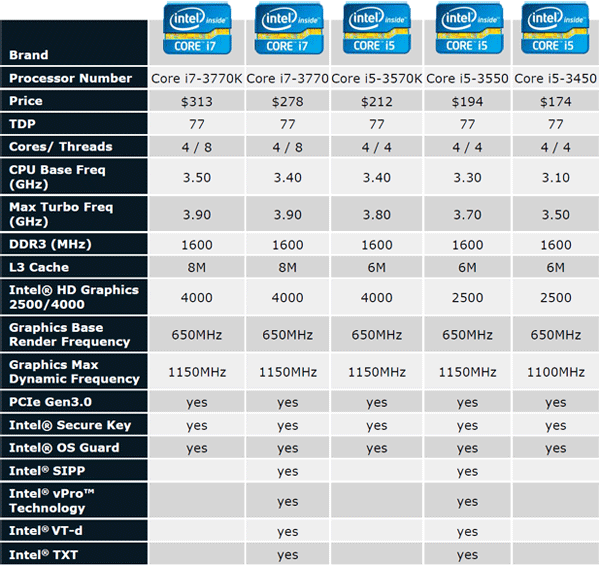Intel Core i7-3770K Ivy Bridge Processor Review
Performance Summary: Intel made summarizing the Core i7-3770K’s performance nice and easy—it is the fastest quad-core processor the company has released to date. The small IPC improvements, in addition to the Core i7-3770K’s higher peak Turbo frequencies give it a slight edge in performance over the Core i7-2700K and i7-3820 in terms of CPU performance. The Core i7-3770K’s integrated Intel HD 4000 series graphics engine, however, is a huge step up from the HD 3000 series engine available in the fastest Sandy Bridge-based processors, like the Core i7-2700K. In some tests, the Intel HD 4000 engine was more than 50% faster than HD 3000. As fast as QuickSync already was in Sandy Bridge, the updated Quick Sync engine in Ivy Bridge also offered significant performance gains over the previous generation.
![]() As we’ve mentioned many times in this piece, Ivy Bridge does not feature a brand-new microarchitecture designed to obliterate the previous generation. Rather, Ivy Bridge, and the 3rd Generation Core processor family based on the microarchitecture, is an evolution of Sandy Bridge that improves upon its predecessor in a number of key ways. If you simply perused our processor-centric benchmarks, the Core i7-3770K we’ve featured here will probably look like a mild upgrade to the Core i7-2700K. It’s true that the enhancements made to the CPU cores don’t equate to a major boost in processor performance. However, the improvements that come to Ivy Bridge by way of its advanced 22nm manufacturing process, improved graphics core, and enhanced Quick Sync media engine propel the 3rd Generation Core processor family well ahead of the previous generation, not only in terms of overall performance, but in power efficiency too. CPU performance may be similar, but graphics and media encoding performance are vastly improved and at significantly lower power. That's good stuff.
As we’ve mentioned many times in this piece, Ivy Bridge does not feature a brand-new microarchitecture designed to obliterate the previous generation. Rather, Ivy Bridge, and the 3rd Generation Core processor family based on the microarchitecture, is an evolution of Sandy Bridge that improves upon its predecessor in a number of key ways. If you simply perused our processor-centric benchmarks, the Core i7-3770K we’ve featured here will probably look like a mild upgrade to the Core i7-2700K. It’s true that the enhancements made to the CPU cores don’t equate to a major boost in processor performance. However, the improvements that come to Ivy Bridge by way of its advanced 22nm manufacturing process, improved graphics core, and enhanced Quick Sync media engine propel the 3rd Generation Core processor family well ahead of the previous generation, not only in terms of overall performance, but in power efficiency too. CPU performance may be similar, but graphics and media encoding performance are vastly improved and at significantly lower power. That's good stuff.

Although we’ve focused on only the highest-end Ivy Bridge-based processor in this article, Intel is launching a number of other products today, including a new “Extreme Edition” mobile processor, eight new Core i7 processors of both mobile and desktop varieties, five new Core i5 processors, and eight new chipsets. We’ll point you to our coverage of the mobile Ivy Bridge launch for more detail on those chips, and to our Z77 round-up for a look at some new Ivy Bridge compatible motherboards, but above is a chart detailing the pricing, features and specifications of the standard desktop processors launching today.
The Core i7-3770K we’ve featured here will debut at $313, putting it right in line with the Core i7-2700K. There is also an unlocked Core i5-3570K on the way, in addition to standard i7-3770, i5-3550, and i5-3450 processors. Not shown in this chart is a quartet of low-power variants as well, with TDPs ranging from 45w – 65w.
All told, the new 3rd Generation Core Processor family looks like another strong offering from Intel. The new chips offer mild CPU performance improvements, lower power consumption, and significantly enhanced integrated graphics with better Quick Sync performance. If you were waiting for Intel’s latest desktop processor to arrive before upgrading, the time has come.

|
|






